What is the Danza de la Pluma?
The Danza de la Pluma (Feather Dance) is a form of dance theater that is practiced in a number of communities near the capital of Oaxaca. It is performed in leather sandals by dancers festooned in colorful garments and ornate feathered crowns, carrying maraca-like rhythmic instruments. The dance is most often portrayed as a melding of indigenous symbols and elements with a story that depicts the European arrival in Mesoamerica and the downfall of Moctezuma Xocoyotzin, the Aztec ruler who reigned on the eve of the Spanish conquest.
The dance is used in its native setting as part of community festivities. Dancers in some villages perform almost non-stop for days around particularly auspicious dates, depicting various scenes and reciting accompanying dialog. The town square is where the dance is most often performed, with an accompanying band of wind and percussion instrumentation.
Where is it from?Permalink
The villages of Zaachila, Cuilapan de Guerrero, and Teotitlán del Valle are among the communities most recognized for their historical and present-day use of the Danza de la Pluma. In each of those three villages, the dance is expressed in a different manner, with notable variations in the costuming, form of the feathered crowns, and specific details of the operatic story portrayed by the dancers.
PractitionersPermalink
Iván Cruz López, the artist responsible for the feathered components of the pieces in the Mestizaje exhibit, also teaches and performs dance in Zaachila. The village is one of the principal communities where the dance is practiced. Cruz and his collaborators are known for being particularly intentional in how they interpret the dance. They express an emphasis on a historical interpretation that retains traditional practices while recasting parts of the story they depict so that it may stay relevant for current and future generations. In place of story components that celebrate the Spanish conquest, the dance in Zaachila celebrates the fortitude of ingenious cultural figures.
The village of Teotitlán del Valle, home to Wilmer Vásquez, the artist responsible for the woolen textiles, practices the dance as well. Visually, the dancers can be easily distinguished by their use of circular feathered crowns rather than the semi-circular shape of the head wear in Zaachila. The dance, as well as other elements of community events, is organized in a complex collective manner in Teotitlán. Young children are given the committed by their parents of performing the dance for a number of years as teenagers or young adults. It is a serious event in many ways, one that conveys social status, but also requires intense dedication. Dancers and their families finance all aspects of the dance, from providing food and beverages to purchasing the elaborate costumes.
Other VenuesPermalink
While the Danza de la Pluma is fundamentally an expression of its local communities in their context, dancers from Oaxaca do often perform for outsiders as well. The annual Guelaguetza in Oaxaca City - a talent show of sorts that features delegations of performers that all gather to represent their communities - is the best-known event that features traditional dance forms from Oaxaca. In such events, the regional dances are typically presented in a relatively condensed exhibition format.
Dance troupes, including Cruz’s group in Zaachila, have also traveled around the globe to present the tradition in other nations.
